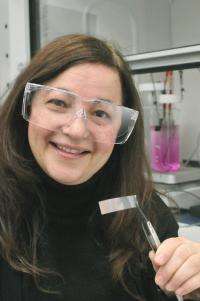Batteries get a quick charge with new anode technology

(PhysOrg.com) -- A breakthrough in components for next-generation batteries could come from special materials that transform their structure to perform better over time.
A team of researchers at the U.S. Department of Energy's Argonne National Laboratory, led by Argonne nanoscientist Tijana Rajh and battery expert Christopher Johnson, discovered that nanotubes composed of titanium dioxide can switch their phase as a battery is cycled, gradually boosting their operational capacity. Laboratory tests showed that new batteries produced with this material could be recharged up to half of their original capacity in less than 30 seconds.
By switching out conventional graphite anodes for ones composed of the titanium nanotubes, Rajh and her colleagues witnessed a surprising phenomenon. As the battery cycled through several charges and discharges, its internal structure began to orient itself in a way that dramatically improved the battery's performance.
"We did not expect this to happen when we first started working with the material, but the anode spontaneously adopted the best structure," Rajh said. "There's an internal kind of plasticity to the system that allows it to change as the battery gets cycled."
According to Argonne nanoscientist Hui Xiong, who worked with Rajh to develop the new anode material, titanium dioxide seemed like it would be unlikely to adequately substitute for graphite. "We started with a material that we never thought would have provided a functional use, and it turned into something that gave us the best result possible," she said.
One of the other researchers in Rajh's group, Sanja Tepavcevic, has adopted a similar approach to make a self-improving structure for a sodium-ion nanobattery.
"This is highly unusual material behavior," added Jeff Chamberlain, an Argonne chemist who leads the laboratory's energy storage major initiative. "We're seeing some nanoscale phase transitions that are very interesting from a scientific standpoint, and it is the deeper understanding of these materials' behaviors that will unlock mysteries of materials that are used in electrical energy storage systems."
The reason that titanium dioxide seemed like an implausible solution for battery development lies in the amorphous nature of the material. Because amorphous materials have no internal order, they lack the special electronic properties of highly ordered crystalline materials. However, amorphous materials have not been known to undergo such profound structural transformations during cycling, according to Rajh. Most of the known battery materials undergo the opposite transition: they start out as highly crystalline and pulverize to an amorphous state upon cycling.
Having anodes composed of titanium dioxide instead of graphite also improves the reliability and safety of lithium-ion batteries. In certain cases, lithium can work its way out of solution and deposit on the graphite anodes, causing a dangerous chain reaction known as thermal runaway. "Every type of test we've conducted on titanium anodes has shown them to be exceptionally safe," Chamberlain said.
The Argonne discovery came from collaboration between two of the laboratory's flagship user facilities: the Center for Nanoscale Materials and the Advanced Photon Source. By combining state-of-the-art nanofabrication techniques with high-intensity X-rays to characterize the nanotubes, the Argonne researchers were able to quickly observe this unusual behavior.
Provided by Argonne National Laboratory


















